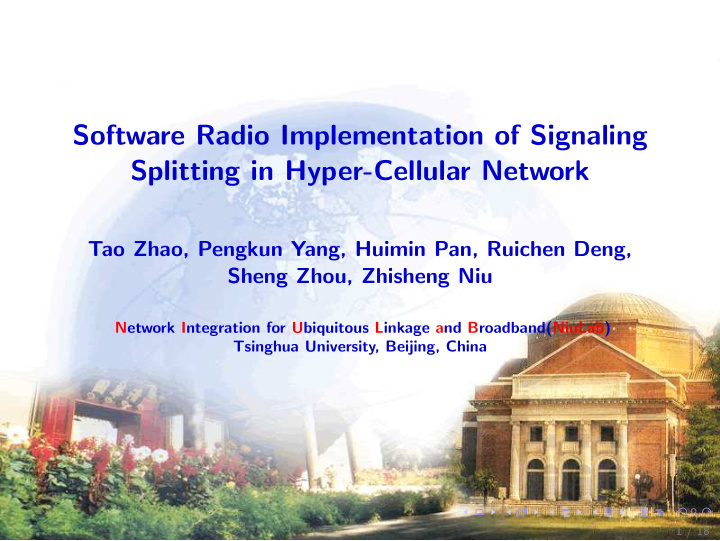



Software Radio Implementation of Signaling Splitting in Hyper-Cellular Network Tao Zhao, Pengkun Yang, Huimin Pan, Ruichen Deng, Sheng Zhou, Zhisheng Niu Network Integration for Ubiquitous Linkage and Broadband(NiuLab) Tsinghua University, Beijing, China 1 / 18
Outline Introduction to Hyper-Cellular Network 1 Signaling Splitting in Current Protocols 2 Software Defined Radio Implementation 3 Summary 4 2 / 18
Outline Introduction to Hyper-Cellular Network 1 Signaling Splitting in Current Protocols 2 Software Defined Radio Implementation 3 Summary 4 3 / 18
Current Cellular Networks Exponential growth of traffic demand Smaller cell size & denser base station deployment Challenges: Energy consumption: BS sleeping → coverage holes Inter-cell interference: CoMP → lack of global info Frequent handovers: signaling overhead Coupling of signaling and data renders the system inefficient! Conventional cellular network 4 / 18
Hyper-Cellular Network Architecture Control data separation (Signaling splitting) Signaling base station (SBS) & data base station (DBS) Benefits Green with DBS sleeping SBS holds global information for CoMP Handover only necessary when switching SBS GREEN: Globally Resource-optimized & Energy-Efficient NW Hyper-cellular network [1] [1] Z. Niu et al. “Energy efficiency and resource optimized hyper-cellular mobile communication system architecture and its technical challenges”. In: SCIENTIA SINICA Informationis 42.10 (2012). In Chinese, pp. 1191–1203. doi : 10.1360/112012-433 . 5 / 18
Service Flow in HCN MU associates to Signaling BS. MU requests for traffic channel, Signaling BS assigns a Data BS and informs MU. Traffic data transmission is estab- lished between MU and Data BS. 6 / 18
Outline Introduction to Hyper-Cellular Network 1 Signaling Splitting in Current Protocols 2 Software Defined Radio Implementation 3 Summary 4 7 / 18
Challenges & Approach Why current protocols? Step from design to practice: feasibility of separation Migration of networks Future protocol design Challenges Millions of signals, difficult to categorize Complicated signal interactions, difficult to separate Seamless UE experience, difficult to guarantee Solution: separate by network functionalities Signaling BS: synchronization, broadcast of system information, paging, low speed data transmission Data BS: synchronization, high speed data transmission 8 / 18
���� �������� �������������� ������������������������ ���������� �� ����������� ����� ������ Mapping �������� ����� ��������� ���� State-functionality mapping ������ ������ Functionality-signal mapping �������� ���������������� �������������� State-functionality mapping [2] �� � ���� Network Functionalities Broadcast of State UE Activities Syn. System Paging Multicast Unicast Information Detached Cell Selection √ √ Acquisition and Update of System √ √ Configuration Monitoring of Upcoming Idle √ Transmission Notification Cell Reselection √ √ Receiving of MBMS √ Acquisition and Update of System √ √ Configuration. Monitoring of Upcoming √ Transmission Notification Active Cell Handover √ √ √ Receiving of MBMS √ Transmission of UE-Specific Data √ [2] X. Xu et al. “On Functionality Separation for Green Mobile Networks: Concept Study over LTE”. . In: IEEE ��������� ��������� ������������������������ Communications Magazine 51.5 (2013), pp. 82–90. issn : 0163-6804. doi : 10.1109/MCOM.2013.6515050 . 9 / 18 ��������� ����� ������������� ������������������������������������������
Channel Separation Channel separation scheme for 3GPP standards: 3GPP Standard GSM/GPRS UMTS R99 LTE R8 BCCH, PCH, AGCH, RACH, S-CCPCH, PBCH, PMCH, SBS PBCCH, PPCH, P-CCPCH, MICH PRACH PAGCH, PRACH DBS PDTCH DPDCH – PSS, SSS, PDSCH, SCH, FCCH, TCH, SCH, CPICH, PCFICH, PHICH, Both SACCH, SDCCH, DPCCH, S-CCPCH PDCCH, PUCCH, FACCH, PDCCH PUSCH Implementation for GSM/GPRS protocol 10 / 18
Outline Introduction to Hyper-Cellular Network 1 Signaling Splitting in Current Protocols 2 Software Defined Radio Implementation 3 Summary 4 11 / 18
Platform Internet OpenBTS PCU SGSN GGSN Hardware: Data BS Signaling BS Data BS Commodity PC USRP N210 Gigabit Ethernet Switch Switch Mobile phone SBS RF DBS RF DBS RF Software: OpenBTS Data Control Signaling Traffic osmocom MU2 MU1 Asterisk SDR platform 12 / 18
Main Work SBS DBS communication UDP sockets Payload: channel description Synchronization Frequency: MIMO cable; GPSDO Time slot: wakeup; correlation Simplified DBS 13 / 18
Progress Phone call separation GPRS data separation SBS log Platform setup DBS log 14 / 18
Vision Hyper-cellular network testbed Typical work flow BS scheduling Performance evaluation . . . 15 / 18
Outline Introduction to Hyper-Cellular Network 1 Signaling Splitting in Current Protocols 2 Software Defined Radio Implementation 3 Summary 4 16 / 18
Summary Hyper-cellular network enables GREEN network operations for cellular networks. Functionality separation approach to achieve signaling splitting Working system on software defined radio platform 17 / 18
18 / 18
Recommend
More recommend